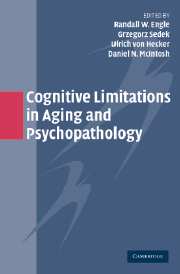Book contents
- Frontmatter
- Contents
- List of Contributors
- Preface
- Acknowledgments
- 1 Cognitive Limitations in Aging and Psychopathology: An Introduction and a Brief Tutorial to Research Methods
- SECTION I WORKING MEMORY AND COGNITIVE FUNCTIONS
- SECTION II AGING AND PSYCHOPATHOLOGY OF COGNITIVE CONTROL
- 5 The Aging of Cognitive Control: Studies of Conflict Processing, Goal Neglect, and Error Monitoring
- 6 Cognitive Control and Schizophrenia: Psychological and Neural Mechanisms
- 7 Aging and Varieties of Cognitive Control: A Review of Meta-Analyses on Resistance to Interference, Coordination, and Task Switching, and an Experimental Exploration of Age-Sensitivity in the Newly Identified Process of Focus Switching
- 8 An Ecological Approach to Studying Aging and Dual-Task Performance
- 9 Cognitive Performance After Preexposure to Uncontrollability and in a Depressive State: Going with a Simpler “Plan B”
- SECTION III ATTENTION, INHIBITION, AND REASONING PROCESSES
- Name Index
- Subject Index
- References
9 - Cognitive Performance After Preexposure to Uncontrollability and in a Depressive State: Going with a Simpler “Plan B”
Published online by Cambridge University Press: 20 May 2010
- Frontmatter
- Contents
- List of Contributors
- Preface
- Acknowledgments
- 1 Cognitive Limitations in Aging and Psychopathology: An Introduction and a Brief Tutorial to Research Methods
- SECTION I WORKING MEMORY AND COGNITIVE FUNCTIONS
- SECTION II AGING AND PSYCHOPATHOLOGY OF COGNITIVE CONTROL
- 5 The Aging of Cognitive Control: Studies of Conflict Processing, Goal Neglect, and Error Monitoring
- 6 Cognitive Control and Schizophrenia: Psychological and Neural Mechanisms
- 7 Aging and Varieties of Cognitive Control: A Review of Meta-Analyses on Resistance to Interference, Coordination, and Task Switching, and an Experimental Exploration of Age-Sensitivity in the Newly Identified Process of Focus Switching
- 8 An Ecological Approach to Studying Aging and Dual-Task Performance
- 9 Cognitive Performance After Preexposure to Uncontrollability and in a Depressive State: Going with a Simpler “Plan B”
- SECTION III ATTENTION, INHIBITION, AND REASONING PROCESSES
- Name Index
- Subject Index
- References
Summary
What is a helpless mind to do? Extending previous work noting parallels between cognitive impairments in depression and after preexposure to uncontrollability (Cox, Enns, Borger, & Parker, 1999; Flett, Vredenburg, & Krames, 1997; Hartlage, Alloy, Vazquez, & Dykman, 1993; Healy & Williams, 1988; Seligman, 1978), we present in this chapter new evidence that the mind switches to a simpler, less effortful “Plan B.” In examining the pattern of performance of complex cognitive tasks observed among helpless or depressed participants, we observe that this lowered level of performance is still clearly above the threshold of random or chaotic behavior. In our presentation of previous and new experimental evidence, we are guided by the view that the switch to the less efficient, but still not chaotic, performance (i.e., a switch to a cognitive exhaustion state, see Kofta & Sedek, 1998; von Hecker, Sedek, & McIntosh, 2000; von Hecker & Sedek, 1999) might represent an adaptive way of adjusting to prolonged uncontrollability and might also describe characteristic aspects of cognitive functioning in depression. In these states, there are not merely decrements across all measures, but instead there are impairments specifically in higher-order processes.
After we recall the origins of uncontrollability research, we unpack our perspective first by noting the similar pattern of cognitive deficits after exposure to uncontrollability among two very smart, although completely different, populations: laboratory rats and high school students. We then describe the cognitive exhaustion model of uncontrollability and depression and briefly summarize existing research evidence.
- Type
- Chapter
- Information
- Cognitive Limitations in Aging and Psychopathology , pp. 219 - 246Publisher: Cambridge University PressPrint publication year: 2005
References
- 5
- Cited by

